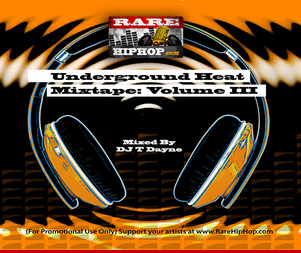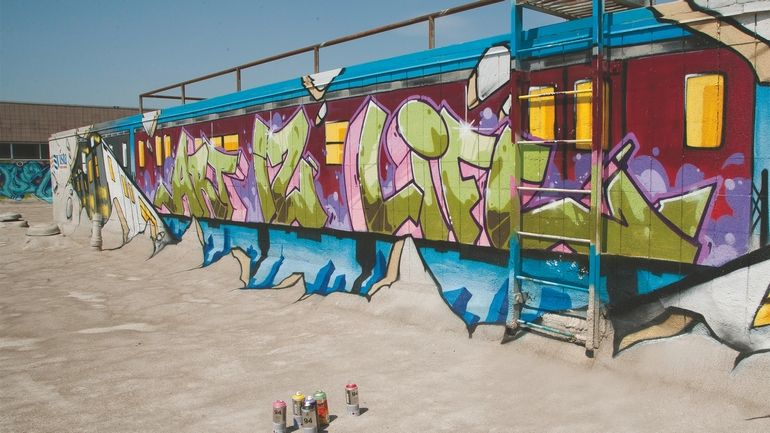Tastemakers at the city's world-class museums or the art-world arrivistes who plunk down millions for a Picasso or Warhol give little respect to paintings sprayed on buildings, bridges or mailboxes. Vinny Pacifico wants to change that.
'I love graffiti,' Mr. Pacifico said. 'I love its energy. I love that it's part of the fabric and history of New York.'
The 60-year-old collector owns a meat-cutting and food-distribution empire in the Bronx with an estimated annual revenue of $1.5 billion—and in a 2,000-square-foot room near his office he maintains a private gallery packed floor-to-ceiling with hundreds of spray-painted murals by dozens of artists. His graffiti collection is surely one of the largest in the city, if not the nation.
'One day, people here are going to wake up to all this, just like they woke up 10 years ago and decided they wanted Kobe or organic beef,' he said. 'And when that time comes, I want the kind of market share in art that I now have in meat.'
Graffiti may well be the city's true indigenous art form, yet it remains shunned by New York collectors who regularly pay huge sums for contemporary works inspired by graffiti imagery. Indeed, the edgiest of art patrons can be fans of what's called street art and at the same time be foes of graffiti. That's because street art tends to look less improvised and is more politically minded, with critiques of state and corporate power. Taggers, meanwhile, spray-paint their names on surfaces in acts that seem less about self-expression and more about self-absorption, an urban update on the World War II street scribble 'Kilroy was here.'
The main reason graffiti art sales have taken off elsewhere but not here may be psychological: To many New Yorkers, it symbolizes an era of blighted subways and decaying neighborhoods they'd rather forget. Ironically, gentrification may actually help the art form make a commercial impact as developers pay for a piece of New York's grittier past.
'There's still a stigma to this art in New York because so many people here lived through the hard times that spawned it,' said Angelo Madrigale, director of contemporary art at auctioneer Doyle New York and organizer of the city's first graffiti auction three years ago. 'The art is a very New York thing, but it's maligned.'
Not so in other global art capitals. Graffiti began crossing over to the commercial mainstream at a 1984 exhibition in Basel, Switzerland. Earlier this month, a painting by the notorious artist Banksy on a side of a trailer in Britain fetched about $680,000 at a Paris auction.
One of the top collectors is U.S. businessman John Axelrod, whose townhouse is decorated with works by such New York artists as Crash, Dondi White and Lee Quinones, who in the 1970s painted more than 100 entire subway cars. The thing is, Mr. Axelrod lives in Boston.
In New York, preservationists are indifferent to the value of the art, and most museums are reticent to show it. Police remain vigilant, with an internal directive calling on officers to paint over graffiti, for instance. In the past 12 months, they have made 1,347 arrests. The most prominent was a graffiti artist with the tag name Cost, who sold a work through Doyle New York in 2013 for $11,875. Cost, whose real name is Adam Cole, was charged with criminal mischief, making graffiti, intent to damage property and possession of graffiti instruments. A hearing is scheduled for July 20.
Meanwhile, historic preservationists don't see the art adding to a building's historical value. A famous graffiti site in Long Island City called 5 Pointz was demolished last year to make way for condos after the city's Landmark Preservation Commission declined to save the building, saying it lacked architectural distinction and the art was less than 30 years old.
Even the Brooklyn Museum backed away from a commitment to display a retrospective this summer, organized by mega-dealer and curator Jeffrey Deitch, called 'Art in the Streets.' It drew 200,000 people three years ago to the Museum of Contemporary Art in Los Angeles. The Brooklyn Museum said it changed its mind because of funding problems, but a portion of the show will be exhibited at Coney -Island this summer.
It didn't help that the Daily News bitterly opposed bringing the show here. 'Museum mavens will be sticking their thumbs in the eyes of every bodega owner and restaurant manager who struggles to keep his or her property graffiti-free,' the -paper snarled in an editorial, 'not to mention the eyes of all New Yorkers who cringe recalling the days of graffiti-covered subway cars.'

Mr. Pacifico said he didn't care for early graffiti that he saw as a youth on trips to visit his grandmother in Brooklyn from his home in Plainview, L.I. But as the art became more colorful and expressive, he found himself admiring the courage of the artists who risked arrest making it and trying to decipher the messages they were conveying. 'This is abstract art that communicates in color, like Picasso, but it also uses language,' he said. 'The art is constantly evolving and turning into something that's accessible. I get excited when I see things evolve, whether it's art or a business.'
But he also knows firsthand how hard it is to change people's minds about the art. Twelve years ago, he closed a West Village gallery that he opened in 1995 to showcase his favorite artists because sales dried up after the World Trade Center attacks.
Today, Mr. Pacifico oversees a beef- and poultry-processing company, Vista Food Exchange, based in the vast Hunts Point marketplace. It supplies restaurants and supermarkets. He expects Vista and four other food distributors he runs to collectively generate $1.5 billion in revenue this year—and he readily credits graffiti with playing a role in his success because its bright, swirling colors emit waves of energy that animate his staffers. 'Put this art in any office,' he said, 'and I guarantee it will wake people up.'
Visitors to his personal office are greeted by a portrait showing half the face of a young African-American woman by a German artist who goes by the moniker Klark Kent. 'I enjoy the best of the original masters,' said Mr. Pacifico, whose collection includes works by Tracy 168, Tats Cru and others.
He won't speculate on what his collection is worth, and says it has never been appraised, but it's clear that it didn't cost much to build. In many cases, all he had to do was provide street artists with cans of paint and let them loose.
In recent weeks, he has summoned about 50 of the city's top graffiti artists to do their thing on the walls of six rooftops atop Hunts Point warehouses. The walls are about the same height as subway cars, giving artists the chance to work on their preferred size of canvas. The first wall, painted to Mr. Pacifico's specifications, reads: 'Art iz life.'
Art may be life, but business is business, and the reason so many graffiti artists have been invited to the Hunts Point rooftops is to replace the art that Mr. Pacifico said he had to destroy last summer for commercial reasons. The roof outside his office had started to leak, threatening the massive refrigerators below and forcing him to bury his beloved graffiti under layers of foamy white sealant.
Much of the covered-up work was made by CES, a Bronx native who started painting subway tunnels and cars in 1983 and these days serves as Mr. Pacifico's artist in residence. He is described as a 'long-revered master' by Baruch College sociologist Gregory Snyder, author of Graffiti Lives.
CES, whose fame overseas is such that his name and art adorn a brand of spray paint sold in Spain, shrugged when asked if he was sad that his patron had obliterated his art. 'You go into this knowing your work could disappear,' he said, observing that it's nice to be outdoors in a private space with a very large, clean slate on which to paint.
The graffiti oasis on Mr. Pacifico's rooftop comes amid signs that the city may at last be coming to terms with the art form so many people around the world perceive as synonymous with New York.
Last month, the New York City Department of Transportation hired graffiti writer Cope2 and five other artists to help with a subway 'tunnel beautification' project in Washington Heights. Mr. Quinones, the artist who covered 100 subway cars decades ago, had his works displayed in a recent show at a Lower East Side pop-up gallery run by veteran dealer Nicole Klagsbrun.
Developers hire taggers
Goldman Properties, which develops luxury apartments in SoHo and the financial district, has invited top-shelf graffiti writers to make their mark on a wall at the corner of Houston and Bowery made famous nearly 40 years ago by Keith Haring.
'Graffiti is now being used for gentrification purposes,' Doyle auctioneer Mr. Madrigale said. 'Its presence is meant to signal that a neighborhood is welcoming to artists.'
Perhaps most important, the arrival of the Whitney Museum in the meatpacking district may signify that uptown grandees are ready to embrace the grittier side of New York art. A spokeswoman said the museum has significant works in its collection by Jean-Michel Basquiat and others who originally were graffiti artists, 'but not graffiti art itself.'
Mr. Pacifico hopes that will soon change. 'Maybe others,' he said, 'will now start to see what I've been seeing all these years.'
crainsnewyork.com



